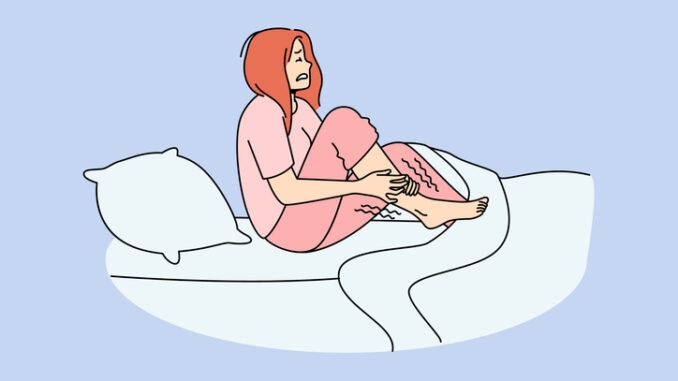
Dr Paul Lambden discusses the causes, diagnosis and treatments for restless leg syndrome
Restless leg syndrome is a common, uncontrollable urge to repeatedly move the legs. It is commonly most distressing during the evening or at night, when sitting or when in bed. It can occur at any age and can present as either occasional and intermittent, or much more frequently. When occurring at night it can disrupt sleep. The condition may be associated with jerky movements, usually of the legs but occasionally of the arms.
The chief symptom is the usually irresistable urge to move the legs. The sensation typically begins when at rest, often after prolonged sitting. It is relieved by movement, by moving the legs, standing or walking about. The symptoms tend to worsen as the day progresses and are worst at night. It is particularly during the night that the jerky leg movements may also occur. For some people the symptoms fluctuate and may disappear for a period before returning. It is believed to affect at least one-in-ten people at some time in their lives and women are twice as commonly affected as men.
People with restless legs may describe ‘sensations’ which feel as if they are inside the limb rather than on the skin. They may be described as aching, itching, creeping, crawling, throbbing or electric in nature; they are not generally described as cramp-like.
Causes of restless leg syndrome
Most commonly, the cause of restless legs is unknown, although there are a number of reasons believed to be the cause or contributive to the condition.
- It has been estimated that up to 60% of cases may be genetic, associated with an autosomal dominant gene, especially if it starts before age 40.
- Another postulation is that the disorder arises as a result of disturbances in the chemical dopamine, which is involved in nerve impulses.
- Others propose that it is associated with a range of medical disorders including sleep apnoea, iron deficiency, kidney disease, vitamin and mineral deficiency and Parkinson’s disease.
- It has been noted to worsen during pregnancy, and oestrogen levels have been implicated as a cause.
- In some cases, it is undoubtedly medication-related.
However, the frequency of the condition is such that the association of the restless legs with particular medical conditions may not simply be a cause and effect.
Historical note
First described by Sir Thomas Willis, in 1672, it was known in the nineteenth century as ‘leg fidgets’. There were various references to it by physicians but, in 1945, Ekbom coined the term ‘restless legs’. It became known as Ekbom’s Syndrome, and later as Willis-Ekbom Syndrome but, in the last decade, the eponymous name has been abandoned in favour of the more descriptive restless leg syndrome.
Consequences
It does not lead directly to other disorders or illnesses; however, its interference with sleep can result in insomnia, daytime tiredness and depression.
Diagnosis
Clearly the medical history is usually diagnostic – i.e. irresistible urge to move the legs, usually when at rest, which is relieved by activity such as walking or stretching. The physician may undertake investigations, such as blood tests, to rule out iron deficiency or hormonal causes. Referral to a sleep clinic may occur if sleep apnoea is suspected. If a related cause is identified and treated, the restless legs syndrome may disappear.
Treatment
Apart from the correction of any conditions thought to be associated with the disorder, a number of treatments have been proposed, although they are not without side-effects which may, on occasion, be as troublesome or more so, as the leg problems.
- Drugs affecting brain dopamine – for example, pramipexole – are a group of drugs called dopamine-agonists and can be used for moderate-to-severe restless leg syndrome. Common side effects are nausea, light-headedness and fatigue.
- Gabapentin, used for some types of seizure and for post-herpetic neuralgia, has been used. Available on prescription, its principal side effects are nausea and vomiting, difficulty with speech and sometimes effects on mood.
- Muscle relaxants may help sleep at night, but they do not eliminate the leg sensations and may cause drowsiness.
- Opioids have been used on occasion to treat severe symptoms but are not normally recommended because of their addictive properties with high or chronic dosage.
Some medications worsen the symptoms of restless legs, such as anti-nausea drugs, allergy medications and anti-psychotic drugs. Generally, these will be avoided in sufferers.


Be the first to comment